
Unfortunately, the sources for information on the food for the Thanksgiving of 1621 are scanty. In fact, there are only two primary sources and neither of them gives many details. Edward Winslow, a colonist who chronicled life in the Plymouth colony, wrote that the governor sent out four men to hunt fowl and they brought back enough to last almost a week. According to Winslow, the Wampanoag Indians who joined the colonists for the feast brought five deer. Governor William Bradford wrote that the colonist had abundant sea food such as cod and bass, and that turkeys were plentiful. A colonist writing a short time after the feast mentions the abundant supply of partridges and quails, in addition to turkeys, but not if they were part of the feast.
The supply of Indian corn at the time is also mentioned by Governor Bradford but in the context of daily consumption. The corn was not the sweet corn we know today and eaten off the cob. Indian corn was ground into meal and made into a flatbread like a pancake, corn mush with a sweetener for breakfast, and stew. Some form of corn was probably eaten at the first Thanksgiving but we have no concrete evidence that it was.
More information comes from modern day experts on colonial and Indian food in general. According to Linda Coombs, an Aquinnah Wampanoag, ‘sopbaheg’ a Wampanoag stew of corn, roots, beans, squash and various meats could have been part of the feast. Clams, lobsters, eels, onions, turnips, and greens like spinach and chard, were also available.
Although pumpkins were available is it very unlikely they were made into pies. The colonists had no ovens and sugar was in sort supply. They could have made a pudding using molasses or honey as a sweetener but no mention is made of the presence of such a pudding at the feast.
 Pudding, stew, fish, meat, fowl, all would have been eaten with knife and fingers. Although forks were introduced from Constantinople into Italy in the 12th century, the English did not adopt them until the 19th century so the entire meal would probably have been eaten without them. I think we can abandon the idea of having a Thanksgiving anything like the first one.
Pudding, stew, fish, meat, fowl, all would have been eaten with knife and fingers. Although forks were introduced from Constantinople into Italy in the 12th century, the English did not adopt them until the 19th century so the entire meal would probably have been eaten without them. I think we can abandon the idea of having a Thanksgiving anything like the first one.